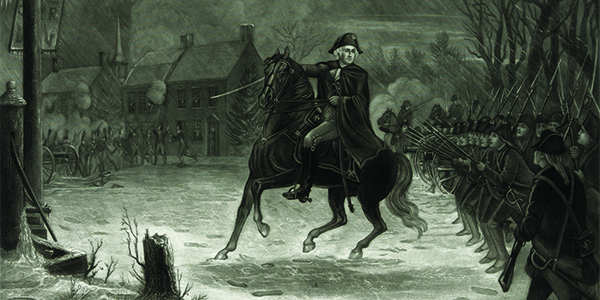The American Revolution started up north with an amazing victory when the upstart Continental Army drove the British out of the city of Boston. The Army clinched the victory by hauling cannons from Fort Ticonderoga in New York to a strategic hill overlooking the city and the encamped British.
But the British didn’t take this defeat lightly. They took revenge by sailing 400 ships and 33,000 soldiers into the New York City area, leading Gen. George Washington’s inexperienced rag-tag army to suffer a series of defeats in Long Island, Queens, Manhattan and Fort Lee, New Jersey. The Army started to openly doubt Washington’s capabilities. It was only a matter of time before the British took back control of the Colonies and hung the rebel leaders as traitors.
Under Washington’s leadership, the Continental Army retreated to Pennsylvania, about ten miles north of Trenton, not far from the Delaware River. Here, my narrative really begins.
As they were retreating, Washington made the brilliant decision to make sure that every boat or barge on the New Jersey side of the Delaware was moved to the Pennsylvania side − a strategic move that would pay off later.
During the winter of December 1776, Washington’s 5,000-man army endured the cold and snow on top of their low morale. They had been beaten in every major battle, and soldiers were leaving in droves to go home to their families. Others stayed only until their enlistment period ended. The army was running out of supplies, and many soldiers literally had no shoes on their feet. The American Revolution was surely a lost cause.
Now, put yourself in George Washington’s shoes at that moment in history. What would you do? What would you say to the troops? How would you get them motivated? How would you get them to stay and fight on? How would you recruit more men to fight for a cause where all hope of victory had already been dashed?
Washington needed a major victory or the jig was up. He realized that they couldn’t wait for the spring because his army was already disintegrating. So, he came up with a bold plan: he would divide up his remaining army into three units. He would lead 2,400 men, horses and cannons and attack the British and Hessian soldiers in Trenton from the north. One of the smaller units would attack from the south and the other from directly across the Delaware River. They would all converge on the British forces in Trenton at the same time. What could possibly go wrong?
All three units would have to cross the partially frozen Delaware River in total darkness in the middle of a blizzard and march nine miles further before they could even begin the fight. Imagine the meetings Washington had with his commanders. What vision did he paint for them about the future? What was his message to his troops that reached into their souls and had them march forward?
Upon reflection, I’m certain that the only tools Washington had at his disposal were his ability to communicate and his ability to move. It’s the same for us: we can communicate and move our bodies − that’s it. Washington must have said some pretty powerful things to the other generals and the troops on board because they did cross the Delaware. They did march on Trenton from the north. They did march on Trenton from the south, and they defeated the British. This began a string of three victories − two in Trenton and one more in Princeton a few days later that changed the direction of the war. Both victories made it possible to recruit men and local militia to fight for the cause. This new momentum ultimately drove the British out of New Jersey and back to New York City.
The vision I want to leave you with is one from firsthand accounts written by soldiers who fought with Washington. To their astonishment, their general would ride his horse to the very front of the battle with apparent disregard for his own life and declare, “Follow me men!” as he pushed forward into enemy fire.
Tomorrow, as you enter your own battle, when you are “up against it,” (whatever that may be for you) how will you respond? What will you say? What will you declare? How clear and powerful will it be? And more importantly, what bold action will you take? Will your team be inspired? Will your team follow you?
Take a lesson from Washington’s leadership. Tread boldy into your business’ battles. Speak with conviction. Lead by example. Instill into your team your shop’s mission. Their support will follow.
Dan Molloy is President and CEO of Molloy Sales Development Group, which helps companies unlock the personal power of each and every employee. Learn more at https://www.molloysales.com/. We also invite you to take advantage of our 20% Growth Blueprint, as part of our 20% in 2020 program.














